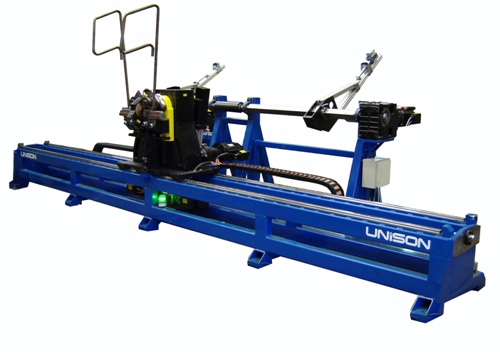At MACH 2012, an international exhibition of machine tools and manufacturing technology, Unison is featuring its all-electric twin-head solid bar and tube bending machines. These machines are mostly used by manufacturers of tubular parts, as they can simultaneously produce two bends and considerably increase the productivity.
 Unison's all-electric twin-head tube bending machine provides an ideal platform for high throughput manufacturing automation.
Unison's all-electric twin-head tube bending machine provides an ideal platform for high throughput manufacturing automation.
The benders can be used for manufacturing parts for furniture, wheelbarrows and supermarket trolleys, as well as automotive components like head rests and seat sub-frames.
Unison’s twin-head benders feature an all-electric architecture and the entire motion axes are controlled by servomotors. They include two separate bending heads, which are supported on independent linear carriages. The design flexibility of the machines allow production of either two-dimensional or three-dimensional parts, as well as both asymmetrical and symmetrical components.
Twin Head Bending Machine - Wheelbarrow Cell With Robot.wmv
Unison’s machines offer higher efficiency and throughput and also provide energy saving benefits. They require minimal operator involvement during manufacturing and need less maintenance. A twin-head bending machine can be operated alone through manual feeding and unloading processes or can be combined with ancillary automation, such as automatic load and unload production cells. The throughput benefits can be realized better with mechanical loading and unloading. Hence, the company has enhanced the design of its bender to simplify addition with tube in-feed and conveyorised unloading systems. The throughput of Unison's twin-head bender depends on various factors, including tube material and size, angle and plane of bends specified and tube on-load and off-load times.
In addition, the machines utilize significantly less energy, enable faster setup and achieve higher bending consistency. Tests have revealed that Unison’s all-electric twin-head machine uses approximately 10% of the energy required by a comparable hydraulically-powered bending machine.